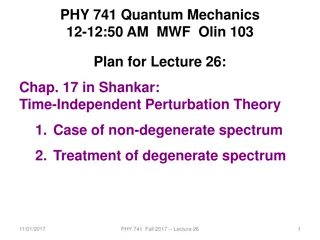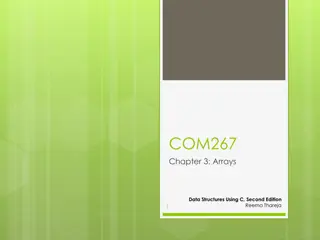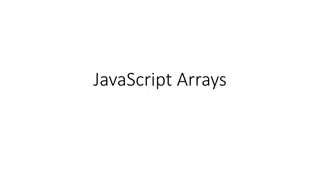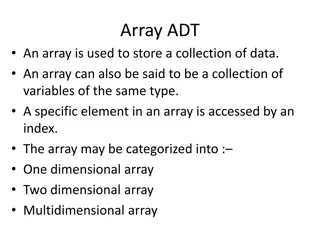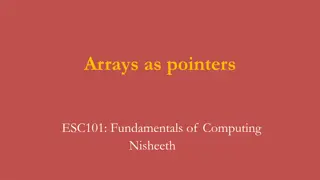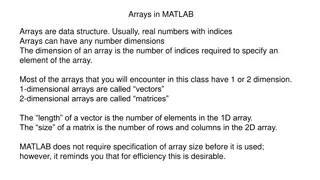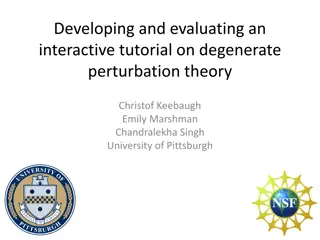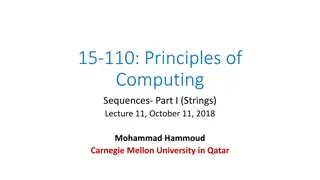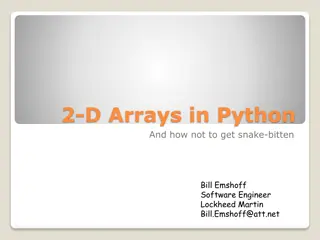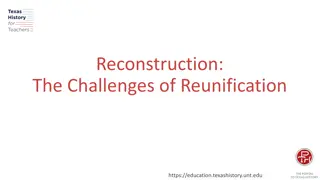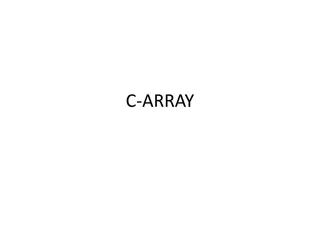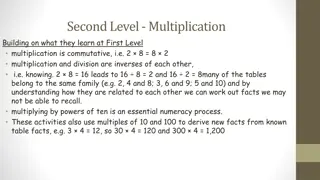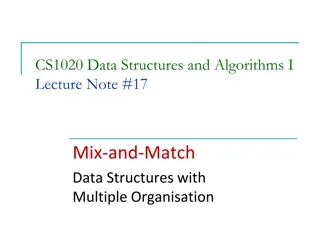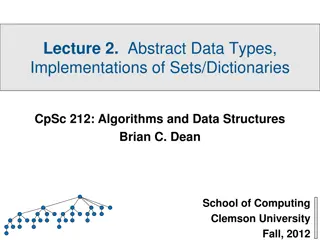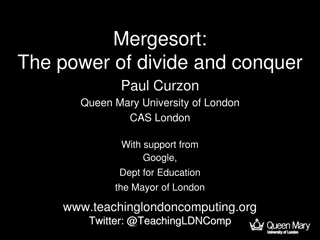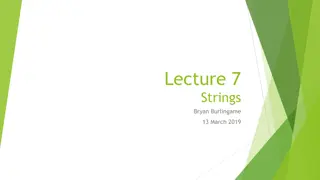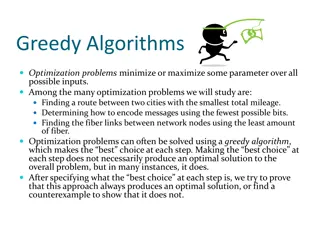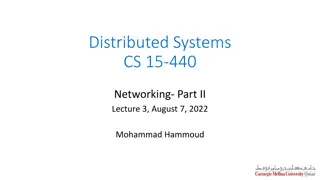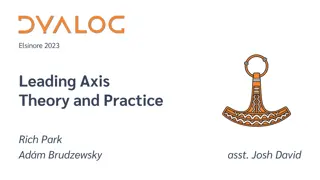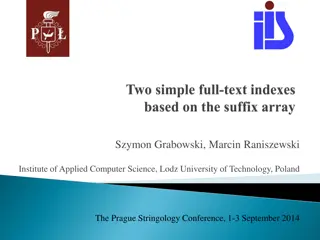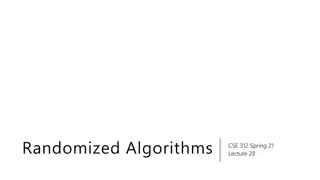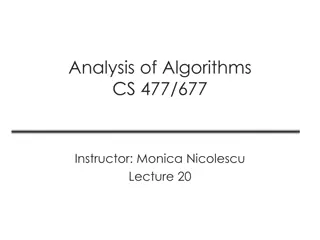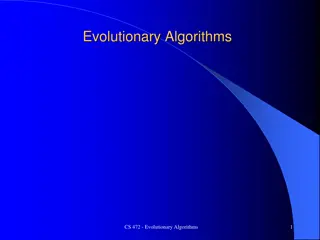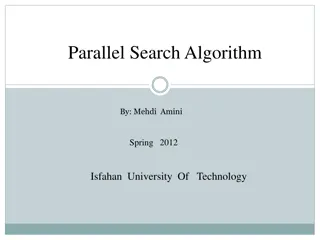Efficient Algorithms for Degenerate String Reconstruction from Cover Arrays
Presented in this extended abstract are efficient algorithms for reconstructing a degenerate string from a valid cover array. The paper discusses the extensive use of degenerate strings in molecular biology for modeling biological sequences and expressing polymorphism. It introduces two algorithms—one utilizing an unbounded alphabet and the other using a minimum-sized alphabet to achieve the reconstruction. The concept of degenerate strings, their sets of letters, and examples are detailed, along with the definition of cover arrays in regular strings.
Download Presentation

Please find below an Image/Link to download the presentation.
The content on the website is provided AS IS for your information and personal use only. It may not be sold, licensed, or shared on other websites without obtaining consent from the author. Download presentation by click this link. If you encounter any issues during the download, it is possible that the publisher has removed the file from their server.
E N D
Presentation Transcript
Degenerate String Reconstruction from Cover Arrays (Extended Abstract) Dipankar Ranjan Baisya, Mir Md. Faysal & M. Sohel Rahman CSE, BUET Dhaka 1000 1
Motivation Extensive use of degenerate string in molecular biology. o used to model biological sequences. (e.g., FASTA format for representing either nucleotide sequences or peptide sequences) o very efficient in expressing polymorphism in biological sequences. (e.g., Single Nucleotide Polymorphism (SNP)) 2
Goal of the Paper Present efficient algorithms to reconstruct a degenerate string from a valid cover array. We have derived two algorithms one using unbounded alphabet and other using minimum sized alphabet for that purpose. 3
Degenerate String Let = { A, C, G, T } 4
Degenerate String Let = { A, C, G, T } Then we can get 2^4 -1 = 15 non-empty sets of letters. 5
Degenerate String Let = { A, C, G, T } Then we can get 2^4 -1 = 15 non-empty sets of letters. At each position of an degenerate string we have one of those sets. 6
Cover Array of Regular String We say that a string S covers a string U if every letter of U is contained in some occurrence of S as a substring of U. Then S is called a cover of U. 11
Cover Array of Regular String We say that a string S covers a string U if every letter of U is contained in some occurrence of S as a substring of U. Then S is called a cover of U. The cover array C of a regular string X[1..n], is a data structure used to store the length of the longest proper cover of every prefix of X. 12
Cover Array of Regular String so for all stores the length of the longest cover of X[1..i] or 0. 13
Cover Array of Regular String so for all stores the length of the longest cover of X[1..i] or 0. since every cover of any cover of X is also a cover of X, it turns out that, the cover array C compactly describes all the covers of every prefix of X. 14
Exp. of Cover Array of Regular string Table 2 : Cover array of abaababaabaababaaba 15
Exp. of Cover Array of Regular string From Table 2 we can see that, cover array of X, has the entries representing the three covers of X having length 11, 6 and 3 respectively. 16
Cover Array for Degenerate String For a degenerate string, the lengths of the covers of stores the list of . 17
Cover Array for Degenerate String For a degenerate string, the lengths of the covers of stores the list of . More elaborately, each is a list such that where denotes the p-th largest cover of X[1..i]. 18
Example of Cover Array for Degenerate String Table 3. Cover Array of aba[ab][ab]a 19
Basic Validation of a Cover Array for we define as of a Cover of . 20
Basic Validation of a Cover Array for we define as of a Cover of . candidate-lengths of covers of is 21
Basic Validation of a Cover Array Further we assume that a symbol is required by . 23
Basic Validation of a Cover Array Further we assume that a symbol is required by . Notably . 24
Basic Validation of a Cover Array Lemma 1. Suppose is the cover array of a string . If , then 25
Basic Validation of a Cover Array Lemma 1. Suppose is the cover array of a string . If , then Proof. proof will be provided in the journal version. 26
Basic Validation of a Cover Array Theorem 2. Proof. proof will be provided in the journal version. 27
CrAyDSRUn we denote by the new set of characters introduced in , i.e., . 30
CrAyDSRUn we denote by the new set of characters introduced in , i.e., . we denote by the set of symbols that are not allowed only at Position , i.e., 31
CrAyDSRUn we denote by the new set of characters introduced in , i.e., . we denote by the set of symbols that are not allowed only at Position , i.e., denotes the set of symbols that can be assigned to . 32
CrAyDSRUn Lemma 3. Proof. proof will be provided in the journal version. 33
CrAyDSRUn: Basic Steps Suppose, we have a cover array where is the product of maximum string length and maximum list length of cover array . 34
CrAyDSRUn: Basic Steps Suppose, we have a cover array where is the product of maximum string length and maximum list length of cover array . so, 35
CrAyDSRUn: Basic Steps step 1, validity checking. 36
CrAyDSRUn: Basic Steps step 1, validity checking. step 2, find . 37
CrAyDSRUn: Basic Steps step 1, validity checking. step 2, find . step 3, find . 38
CrAyDSRUn: Basic Steps step 1, validity checking. step 2, find . step 3, find . step 4, place new character in proper positions. 39
CrAyDSRUn: Step 1 scan/proceed one position at a time from left to right i.e., in an online fashion. check validity at each position of input array according to Basic Validation section of a cover array. 40
CrAyDSRUn: Step 1 as soon as it finds a violation of validity the algorithms returns the input array as invalid. for further validation see Lemma 4 and Lemma 5 (Slide no. 45 and 46). 41
CrAyDSRUn: Step 2 for each , our algorithm finds for each . . 42
CrAyDSRUn: Step 2 for each , our algorithm finds for each . . our algorithm finds with the help of Lemma 4 and Lemma 5.(see next slides) 43
CrAyDSRUn: Step 2 Lemma 4. Proof. proof will be provided in the journal version. 44
CrAyDSRUn: Step 2 Lemma 5. Proof. proof will be provided in the journal version. 45
CrAyDSRUn: Step 2 we can see from Lemma 4 and Lemma 5 that we need to perform intersection operation. Finding intersection will take . so for each position step 2 takes . 46
CrAyDSRUn: Step 3 similar to step 2. find using Lemma 3.(see slide no.34) for that our algorithms finds a set of in a similar way of finding except that instead of there will be iterations for each . in previous step 47
CrAyDSRUn: Step 3 similar to step 2. find using Lemma 3.(see slide no.34) for that our algorithms finds a set of in a similar way of finding except that instead of there will be iterations for each . in previous step then . 48
CrAyDSRUn: Step 3 so for each position step 3 takes . 49
CrAyDSRUn: Step 4 if where then 50



